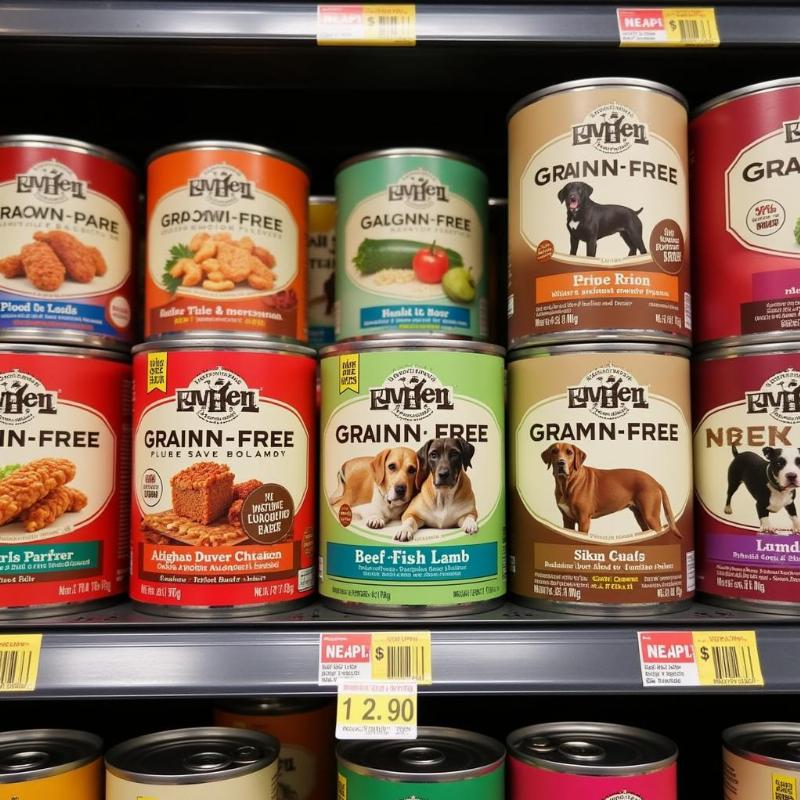Grain-free canned dog food has become increasingly popular in recent years, with many pet owners believing it offers numerous health benefits. But what exactly is grain-free dog food, and is it the right choice for your furry friend? This comprehensive guide will explore everything you need to know about grain-free canned dog food, helping you make informed decisions about your dog’s nutrition.
Understanding Grain-Free Canned Dog Food
What does “grain-free” actually mean? Simply put, it signifies the absence of grains like wheat, corn, rice, barley, and oats. These ingredients are often used as fillers in pet food, providing carbohydrates for energy. However, some dogs may have sensitivities or allergies to these grains. Grain-free canned dog food offers an alternative, often substituting grains with ingredients like potatoes, sweet potatoes, peas, lentils, or tapioca. These alternatives provide carbohydrates while potentially avoiding allergic reactions.
 Different types of grain-free canned dog food available on the US market
Different types of grain-free canned dog food available on the US market
Benefits of Grain-Free Canned Dog Food
- Allergy Management: For dogs with grain sensitivities, a grain-free diet can significantly improve their health, alleviating symptoms like itchy skin, digestive issues, and ear infections.
- Improved Digestion: Some dogs find grain-free food easier to digest, leading to better stool quality and reduced bloating.
- Shiny Coat and Healthy Skin: Many pet owners report shinier coats and healthier skin after switching to a grain-free diet. This can be attributed to the higher protein and fat content found in many grain-free formulas.
- Increased Energy Levels: With digestible carbohydrates and higher protein, some dogs experience increased energy levels on a grain-free diet.
Choosing the Right Grain-Free Canned Dog Food
Selecting the right grain-free canned dog food can feel overwhelming with so many options available. Consider the following factors:
- Life Stage: Puppies, adult dogs, and senior dogs have different nutritional requirements. Choose a formula designed for your dog’s specific age.
- Breed Size: Small, medium, and large breeds also have varying needs. Consider your dog’s size when selecting a formula.
- Protein Source: Look for high-quality protein sources like chicken, beef, fish, or lamb. Avoid generic terms like “meat meal.”
- Ingredients: Carefully examine the ingredient list, opting for whole foods and avoiding artificial flavors, colors, and preservatives.
Potential Concerns and Considerations with Grain-Free Diets
While grain-free diets offer many potential benefits, it’s crucial to be aware of potential concerns:
- Dilated Cardiomyopathy (DCM): The FDA is investigating a potential link between grain-free diets and DCM in dogs. Although more research is needed, it’s essential to discuss any concerns with your veterinarian.
- Nutritional Deficiencies: If not formulated correctly, grain-free diets can potentially lead to nutritional deficiencies. Choose a brand that adheres to AAFCO (Association of American Feed Control Officials) guidelines.
Is Grain-Free Canned Dog Food Right for My Dog?
Ultimately, the decision of whether to feed your dog a grain-free diet is a personal one best made in consultation with your veterinarian. They can help you assess your dog’s individual needs, any potential allergies, and the best dietary approach.
Conclusion
Grain-free canned dog food offers a valuable alternative for dogs with grain sensitivities or those who thrive on such diets. By carefully evaluating your dog’s needs, consulting with your veterinarian, and choosing a high-quality brand, you can help ensure your furry friend receives the best possible nutrition. Remember to prioritize a balanced, complete diet that supports their overall health and well-being.
FAQ
- What are the most common grains found in dog food? The most common grains found in dog food are wheat, corn, rice, barley, and oats.
- What are the signs of a grain allergy in dogs? Signs of a grain allergy in dogs can include itchy skin, digestive problems, ear infections, and excessive licking or chewing of paws.
- Are all grain-free dog foods created equal? No, the quality of grain-free dog foods varies considerably. Look for brands that prioritize high-quality protein sources, whole foods, and avoid artificial ingredients.
- How can I transition my dog to a grain-free diet? Gradually introduce the new food over several days, mixing it with their current food to avoid digestive upset.
- What should I do if I suspect my dog has a food allergy? Consult your veterinarian. They can perform tests to identify the allergen and recommend the best course of action.
- Is grain-free dog food more expensive? Grain-free dog food can be more expensive than traditional dog food due to the alternative ingredients used.
- Where can I buy grain-free canned dog food? Grain-free canned dog food is readily available at pet stores, online retailers, and some grocery stores across the US.
Related Articles
- salmon grain free dry dog food
- poultry-free dog food with grain
- grain free poultry free dog food
- grain free beef dog food
Beautdogs.us is your premier online destination for comprehensive, trustworthy, and engaging information on all aspects of dog care, breed insights, and product recommendations. Whether you’re a new dog owner or a seasoned expert, Beautdogs.us provides expert advice on everything from nutrition and training to health and wellness. We’re passionate about helping you provide the best possible care for your canine companion. Contact us today for personalized guidance! Email: [email protected], Phone: +1 501-555-7529.